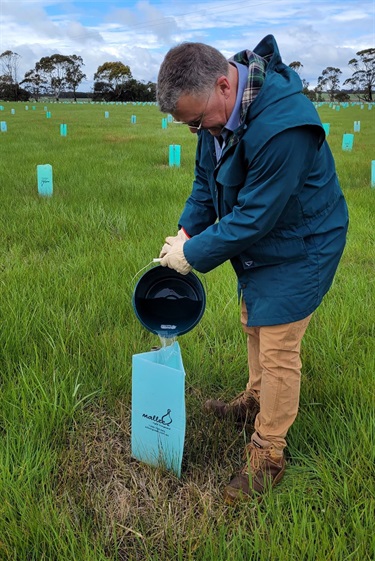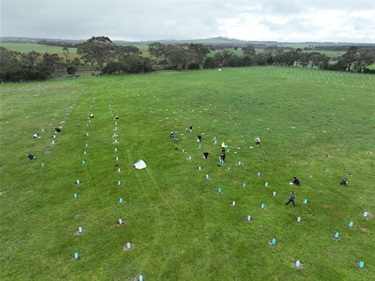
An 11-hectare former farming paddock in Buckley is being transformed into native habitat, as part of Council's carbon offsetting and environmental planting project.
The project has brought together local schools, community groups and volunteers to help restore biodiversity to the area.
Located next to Lake Modewarre, the Council-owned site connects directly to the lake's ecosystem. It provides a refuge for birds, reptiles and insects and shade for kangaroos and wallabies that pass through the area.
10,000+ trees help return site to natural habitat
Over 10,000 trees have been planted, with rocks and timber logs strategically placed across the site, all helping to add complexity and diversity to the habitat. Since planting commenced, species such as spotted marsh frogs and quail have returned to the site.
The project is a small step in reversing the loss of native vegetation, with 95% of the district historically cleared. Replanting the site not only helps capture carbon but also rebuilds important ecological links.
"This project is about more than planting trees, it's about restoring an entire landscape, said Cr Tony Phelps.
"It will support wildlife and gives our community a living connection to the land for generations to come."
A true community effort
Partnerships have been central to the project's success. Torquay and District Landcare Group provided gloves and hand tools and recruited and organised planting days with Moriac Primary School, Bellbrae Primary School, Friends of Lake Modewarre, Surf Coast Secondary School and All Aboard. Every year Torquay Rotary has provided a well-earned BBQ lunch after planting for all the hungry volunteers.
The native plants were grown by local nurseries, Otway Greening and Otway Indigenous Nursery, using seeds collected form remnant vegetation along nearby roadsides, ensuring the restoration reflects the area's natural landscape.
Species planted include a diverse mix of wattles, gums, sheoaks and shrubs.
"Working with Landcare, schools and the community, we have been able to create something that will grow stronger every year," said Cr Phelps.
"I really enjoyed getting on site recently and planting some trees. I will now proudly watch them grow and enjoy seeing this area revegetated," he said.
Estimates by Corangamite Catchment Management Authority show that approximately 920 tonnes of carbon will be sequestered 25 years after planting.
Council has endorsed to retain and protect this site for a minimum of 50 years to ensure its success as a carbon offset site.









